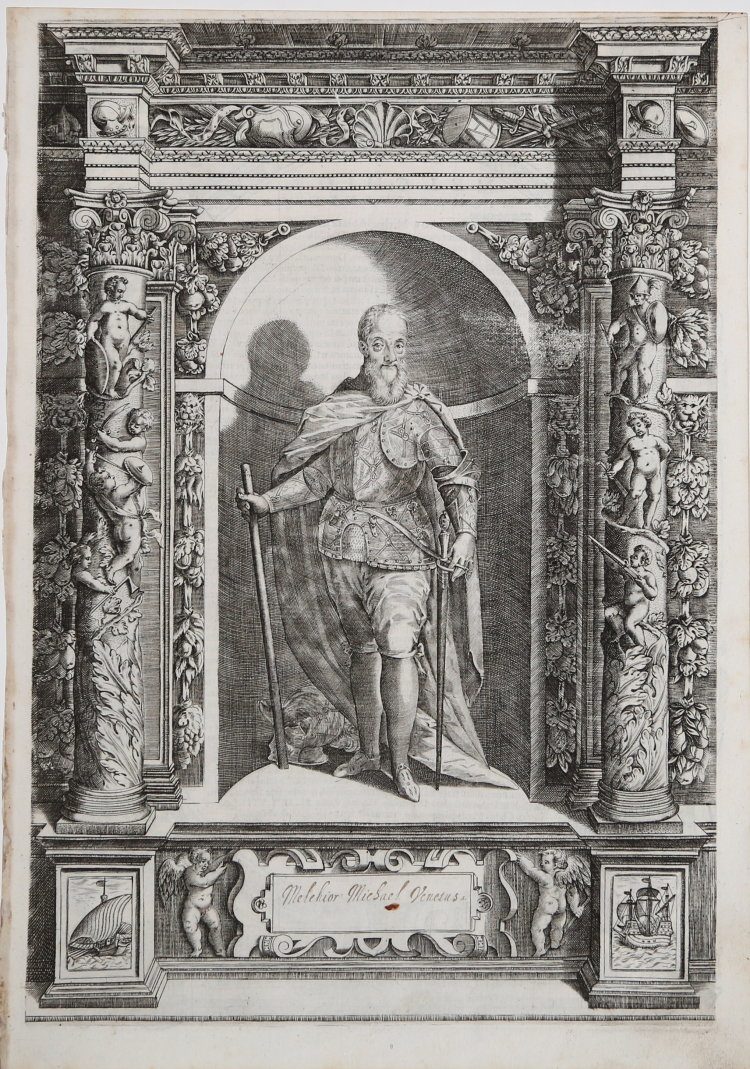



| Reference: | S38806 |
| Author | Domenicus CUSTOS |
| Year: | 1601 |
| Measures: | 290 x 4247 mm |


| Reference: | S38806 |
| Author | Domenicus CUSTOS |
| Year: | 1601 |
| Measures: | 290 x 4247 mm |
Portrait of Melchiorre Micheli, full-length, facing front, wearing armour and holding a staff in his right hand; within a niche, flanked on either side by decorated Corinthian columns.
Engraving, circa 1601. A fine impression, printed on contemporary laid paper, with margins, good condition. Latin text on verso, first edition.
Plate from Augustissimorum Imperatorum ... regum... verissimae imagines… (also known as Armamentarium Heroicum), the catalogue of the arms collection Archduke Ferdinand II kept at Ambras castle; it was first published in Innsbruck in 1601. It was illustrated with a frontispiece and 125 portraits of European princes in full armour, with decorative surroundings. The plates were engraved by Dominicus Custos after designs by Giovanni Battista Fontana. Each plate was accompanied by a short biographical text on the former owner of the armour, written by Jacob Schrenk von Notzing.
A German translation of the book (by J. E. Noyse von Campenhouten) was published in 1603 under the title Der aller Durchleuchtigisten und Grossmächtigen Kayser, Durchleuchtigisten unnd Großmächtigen Königen[...].
A third edition including 123 plates was issued in Innsbruck in 1605.
|
Hollstein 60.
|
|
Dominicus Custos (1560–1612) was a Flemish artist, printer and copperplate engraver, who worked in the service of Emperor Rudolph II in Prague.
Dominicus was born in Antwerp, the son of Pieter Balten, and settled in Augsburg as the second husband of the widow of Bartholomäus Kilian (1548–1588), a goldsmith from Silesia and the father of Wolfgang and Lukas Kilian; they were trained by Dominicus in the art of engraving after their father's death. Dominicus was the father of David Custodis, also an Augsburg engraver.
Custos and the humanist Marcus Henning collaborated in producing the work "Tirolensium principum comitum" which appeared in 1599 and depicted 28 Counts of Tyrol from Albert IV (1190–1253) to Rudolf II (1552–1612). Custos was responsible for the engravings while Henning took care of the text and eulogies.[
Between 1602 and 1604 he published the "Atrium heroicum" in four parts. This was a collection of 171 engraved portraits of rulers, nobles, statesmen, dignitaries, celebrities, military leaders and important businessmen of the 16th century-
In 1605 he published a collection of engraved portraits of scholars, Clarissimorum aliquot litteris, ingenio, fama virorum effigies (Augsburg, Christophorus Mangus, 1605).
Custos died in Augsburg. His sons Raphael, David and Jacob Custos continued his workshop.
|
|
Hollstein 60.
|
|
Dominicus Custos (1560–1612) was a Flemish artist, printer and copperplate engraver, who worked in the service of Emperor Rudolph II in Prague.
Dominicus was born in Antwerp, the son of Pieter Balten, and settled in Augsburg as the second husband of the widow of Bartholomäus Kilian (1548–1588), a goldsmith from Silesia and the father of Wolfgang and Lukas Kilian; they were trained by Dominicus in the art of engraving after their father's death. Dominicus was the father of David Custodis, also an Augsburg engraver.
Custos and the humanist Marcus Henning collaborated in producing the work "Tirolensium principum comitum" which appeared in 1599 and depicted 28 Counts of Tyrol from Albert IV (1190–1253) to Rudolf II (1552–1612). Custos was responsible for the engravings while Henning took care of the text and eulogies.[
Between 1602 and 1604 he published the "Atrium heroicum" in four parts. This was a collection of 171 engraved portraits of rulers, nobles, statesmen, dignitaries, celebrities, military leaders and important businessmen of the 16th century-
In 1605 he published a collection of engraved portraits of scholars, Clarissimorum aliquot litteris, ingenio, fama virorum effigies (Augsburg, Christophorus Mangus, 1605).
Custos died in Augsburg. His sons Raphael, David and Jacob Custos continued his workshop.
|